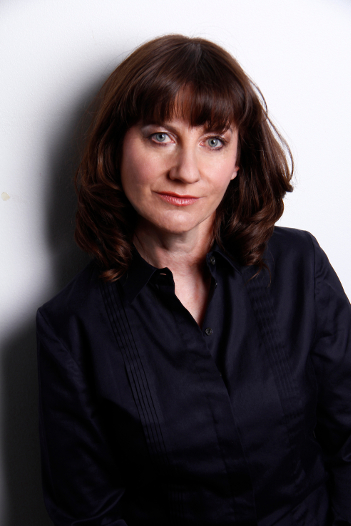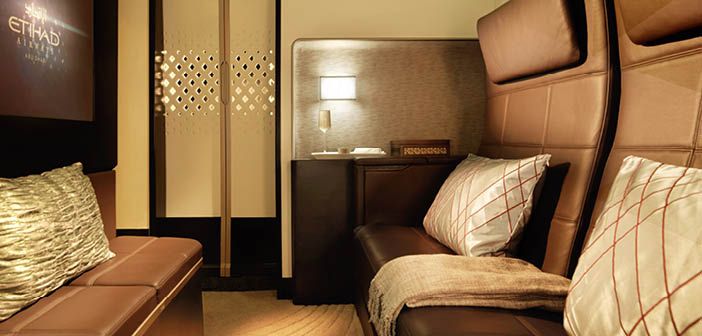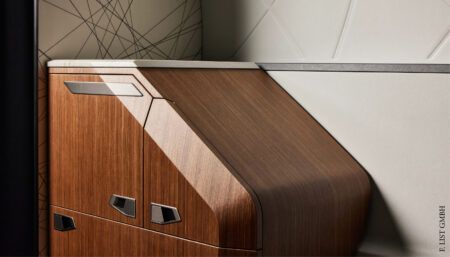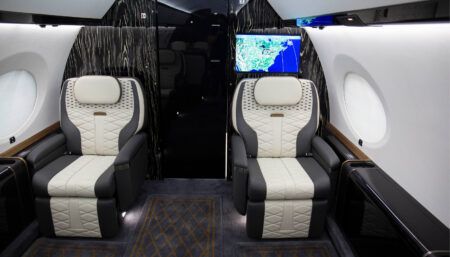Catherine Barber, color, material and finish consultant at Acumen Design Associates, discusses the overlap between VIP and commercial aircraft design, and highlights her favorite trends
 What projects have you undertaken in the VIP/business jet sector?
What projects have you undertaken in the VIP/business jet sector?
My most recent VIP project [was] creating the finishes for The Residence (below) – Etihad’s A380 suite, aimed at bringing the level of luxury and sophistication one would find in the business or private jet sector to the commercial sector.
Our brief was to create a whole new VIP class, the first ever on a commercial aircraft. It has all the hallmarks of a private jet: hand-tufted carpets, marquetry table tops, bespoke light features, walls clad in signature fabric panels to reduce noise, a private shower room in sleek black finishes with touches of gold and a double bedroom with bespoke leather bed head and cabinetry. All the upholstery and leather was by Poltrona Frau, who produce not only the Ferrari seats, but also have their own top-tier furniture range, which is featured in five-star hotels and luxury homes all over the world.
One of the reasons that the Residence project was my favorite was that it allowed us to bring that luxury and attention to detail to all of the classes. In the economy cabins we created the Smart Seat with extra head rest support and breakout areas in the galley. The lavatories are based on five-star hotels and bars in Abu Dhabi, with floor-to-ceiling mosaic gradients sporting hand-applied silver foils.
What is the common ground between the VIP and commercial aviation sectors and what are their differences?
In both cases our brief and ambition is to create the most comfortable and aesthetically pleasing passenger experience possible in a highly technical and heavily certified environment. For commercial aircraft, even in first class, the cabin has to withstand the traffic and heavy use (some might say abuse) that results from the high level of occupancy and necessity to keep the aircraft generating revenue. This means we have to be really creative to extract the very best out of a limited palette of materials.
 What would you like each industry to learn from the other?
What would you like each industry to learn from the other?
The VIP aviation industry sets many of the aesthetic ambitions for us – the cabinetry, the hand finishing, the pale colors we would love to use! The possible scope of non-seating areas such as lounges, bathrooms and bedrooms on a larger business or private jet has inspired us to create versions of these in commercial aircraft, to raise the luxury levels in first and business class and really provide a VIP experience for the passenger. But VIP interiors can often be more traditional than commercial, as the commercial pressures on airlines drive faster and faster turnover of designs and ideas in not just the product, but the service too. Competition between design agencies is driving more and more inventive thinking and the VIP market can now look to the innovations and ambitious interior schemes in the commercial sector for inspiration, rather than the other way around.
Where do you draw your inspiration from?
Inspiration can come from anywhere. We visit international design shows; the Milan Furniture Fair is top of the list for me, being the largest interior design festival (combined with Italian flair). The team also visits automotive and marine shows and at the office we are surrounded by Clerkenwell Design Week and top international furniture showrooms. We also benchmark hotels and hospitality environments, trends in food and service culture and new technologies.
 What designs, materials and technologies have caught your eye recently?
What designs, materials and technologies have caught your eye recently?
I am really interested in how 3D printing is going to change the way we see and realize pattern onto surfaces. In the past, textiles, laminates and so on were essentially 2D decorative effects, but this is changing and will filter down. I love the concept that the structure, functionality and decorative elements of a product are intrinsically linked. At the Camper (Spanish shoe brand) exhibition at the Design Museum in London, I recently saw a shoe formed from printing a 3D plastic polymer directly onto a technical textile material, thereby transforming it from a 2D fabric to a completely formed shoe upper in a single process. I also visited Techtextil in Frankfurt, Germany, this year to research conductive and technical textiles. We are all inspired by interactive surfaces and the possibilities of new thin and flexible screens and light-emitting textiles and plastics.
Can you think of ways to translate these into aircraft interiors?
I envision future generation seats being far more interactive; gesture controls to stop the passenger behind you stabbing at their screen/your headrest will be a boon for economy passengers, as will meal tables that dock, recharge or even transform into your technology interfaces. In the premium classes we are dreaming of fully wraparound screens that can become your window to the sky, built-in sound systems to do away with headphones and materials that emit light and heat so passengers can control their own personal environments.
 Have you noticed any aesthetic trends recently?
Have you noticed any aesthetic trends recently?
I am bombarded with them! One of my favorites is the space and astronomy theme featuring in so many interior products at the moment, for example the Diesel (jeans brand) interior and tableware collection. We are combining satellite imagery from NASA with marble and stone textures to create rich iridescent finishes for wall and furniture laminates. I hope that when you board my next aircraft you could be forgiven for thinking we are taking you to Jupiter, not Seattle.
What do you find most challenging and most exciting about designing aircraft interiors?
Unlike much ground-based interior design, we can create completely bespoke environments. Every piece of furniture, every surface the passenger touches, can be developed as a unique piece. Everything has to be modular and multifunctional to act as your sitting room, dining room and bedroom all in one – so we have to think beyond pure styling to true multifunctionality. As a textile designer, I love the challenge of creating unique finishes which reflect the many different cultures and brands I work for and to elevate what can be a very dull interior experience to one that delights and surprises, engaging the jaded frequent flyer and making them see that air travel can be glamorous again.





